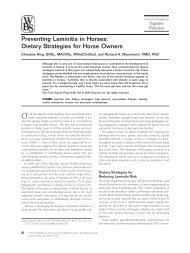Nutritional Secondary Hyperparathyroidism in the Horse
Nutritional Secondary Hyperparathyroidism in the Horse
Nutritional Secondary Hyperparathyroidism in the Horse
Create successful ePaper yourself
Turn your PDF publications into a flip-book with our unique Google optimized e-Paper software.
Ration 41<br />
Table XI/. Calcium and phosphorus contents of experimental and control diets<br />
NSH horses Control horse<br />
Week G. Ca/day G. P/day Ca : P G. Ca/day G. P/day Ca : P<br />
0-23 15.80 58.14 1 : 3.68 21.26 15.08 1.41 : 1<br />
24-41 14.17 87.77 1 : 6.19 21.26 15.08 1.41 : 1<br />
2. Ration<br />
The experimental and control &ets are given <strong>in</strong> Tables XI11 and<br />
XIV. Table XI11 relates to <strong>the</strong> first 23 weeks. From week 24 through<br />
week 41 <strong>the</strong> hay was decreased from 3.64 kg. a day to 2.73 kg. a day,<br />
<strong>the</strong> wheat bran was <strong>in</strong>creased from 2.73 kg. a day to 4.09 kg. a day, and<br />
and <strong>the</strong> phosphorus supplementation was <strong>in</strong>creased from 11.58 g. a day<br />
to 23.16 g. a day. The calcium and phosphorus contents dur<strong>in</strong>g <strong>the</strong><br />
experiment are summarized <strong>in</strong> Table XV.<br />
Hy. Timothy hay with m<strong>in</strong>or amounts of weeds and native<br />
grasses was used. The hay was grown locally and field-cured 2 months<br />
prior to <strong>the</strong> beg<strong>in</strong>n<strong>in</strong>g of <strong>the</strong> experiment. Total prote<strong>in</strong>, calcium, and<br />
phosphorus were determ<strong>in</strong>ed once from representative samples of 20<br />
bales of hay.<br />
Soft wheat bran and “Omolene” (Table XIV) were <strong>the</strong> gra<strong>in</strong> pro-<br />
ducts used <strong>in</strong> <strong>the</strong> ration for experimental and control horses, respec-<br />
tively. Total prote<strong>in</strong>, calcium, and phosphorus were determ<strong>in</strong>ed once<br />
from 18 bags of bran and 10 bags of “Omoleney’.<br />
Water. The source of dr<strong>in</strong>k<strong>in</strong>g water was <strong>the</strong> water supply of <strong>the</strong><br />
city of Ithaca, New York. The calcium content was checked twice.<br />
Phosphoruf supplementation. Monosodium phosphate was given as a<br />
supplemental phosphorus source to NSH 1, and <strong>the</strong> o<strong>the</strong>r NSH horses<br />
were given disodium phosphate. The sodium phosphate was of a<br />
technical grade. The supplement was dissolved <strong>in</strong> <strong>the</strong> dr<strong>in</strong>k<strong>in</strong>g water<br />
daily.<br />
Sodium chloride was fed free choice from blocks <strong>in</strong> <strong>the</strong> stalls.<br />
3. Physical Exam<strong>in</strong>ation<br />
The animals were observed daily, and rout<strong>in</strong>e physical exam<strong>in</strong>a-<br />
tions were made at monthly <strong>in</strong>tervals.<br />
Downloaded from<br />
vet.sagepub.com by guest on April 14, 2010



